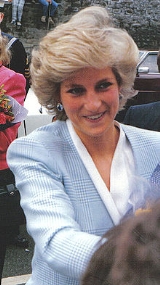
; 1 July 1961 31 August 1997) was the first wife of Charles, Prince of Wales
, whom she married on 29 July 1981, and an international charity and fundraising figure, as well as a preeminent celebrity of the late 20th century. Her wedding to the Prince of Wales, held at St Paul's Cathedral
, was televised and watched by a global audience of over 750 million people. After this marriage she received the courtesy titles Princess of Wales
, Duchess of Cornwall
, Duchess of Rothesay
, Countess of Chester and Baroness of Renfrew.
She won't go quietly, that's the problem. I'll fight to the end, because I believe that I have a role to fulfill, and I've got two children to bring up.![]()
I'd like to be a queen of people's hearts, in people's hearts, but I don't see myself being Queen of this country. I don't think many people will want me to be Queen.![]()
I do things differently, because I don't go by a rule book, because I lead from the heart, not the head, and albeit that's got me into trouble in my work, I understand that.![]()
Everyone needs to be valued. Everyone has the potential to give something back.![]()

